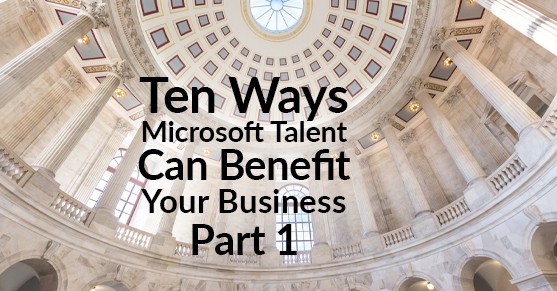Since 2002, Microsoft has been developing and improving various business products for enterprise management planning (ERP), an operation of theirs that started when Microsoft acquired the accounting application suite, Navision A/S, and released Axapta 3.0. Over the years, Microsoft has continued to expand on these applications with products such as Microsoft Dynamics AX 4.0 through AX 7, and the popular Dynamics 365 for Finance and Operations (Business edition and Enterprise edition). And, as of July of 2016, the Dynamics 365 product line has extended into Customer Relationship Management (CRM), offering a “Customer Engagement Plans” for CRM and a “Unified Operations Plan” for ERP and HR.
In the first part of this blog, we’ll look into what Microsoft Talent is, and one of the major features it offers to business users: Attract.
What is Talent?
As part of the Unified Operations Plan of Dynamics 365 for Finance and Operation, users have access to several applications to help with ERP, including one of the more beneficial applications, Dynamics 365 for Talent, for aid in recruitment and staffing.
Talent allows your organization to move beyond traditional human resource management to transform the candidate and employee experience. Dynamics 365 for Talent uses the power of Office 365 and LinkedIn to attract, hire, onboard, and retain talented people. When you add Dynamics 365 for Talent into your HR architecture, you unleash the power of the Microsoft Cloud — creating a more secure, intelligent, and connected organization.
Free yourself from the barriers that prevent you from winning top talent and enabling their success. Modernize recruiting, applicant tracking, and employee onboarding by connecting your HR to IT, people to insights, and allows your business to grow. With the primary applications of the Talent suite in mind — including Attract, Onboard, Core HR, and the new features in place — here are ten ways that Microsoft Dynamics 365 for Talent can benefit your business.
Attract
1) Candidate Search
Connect recruiters, managers, and interviewers to better collaborate and attract top talent. Tailor the hiring experience with configurable stages and activities, create compelling job descriptions, and then post them to your company career site, popular job boards or Talent’s dedicated employment page. The system allows you to unify candidate profiles, pools, and pipelines. Highlight and track candidates who will be valuable future hires with talent pool track. Monitor the hiring process, and get insights on candidate skills, competencies, and interview feedback. Candidate profiles are compared to job requirements to intelligently highlight top applicants. Interactive dashboards help you understand the health of your recruiting pipeline to improve your quality of hire.
2) Hiring Team Organization and Talent History
Once prospects have been singled out, managers can assign roles to different users, creating a specified hiring team with individual duties to be carried out at certain times in the hiring process. Through this, the hiring team can track candidate analytics, facilitate equal employment opportunity (EEO) and the Office of Federal Contract Compliance Program (OFCCP) support, and conduct several assessments to address personality and company culture fit.
3) Engagement Activities
Once duties and roles have been assigned, managers can formulate mandatory activities and set up workflow necessities in Attract to streamline the hiring process. Activities can provide status updates for certain positions to be filled and workflows can offer a roadmap for mandatory actions for both the employer and potential client.
4) Offer Management
Increase the accuracy and speed of extending offers to selected candidates with streamlined offer management. Configurable workflows, templates, and approval processes help ensure that hiring managers, recruiters, and HR specialists efficiently collaborate to create compelling offers. After the entire candidate processing, interviewing, and hiring process have been completed and the employer is ready to make an offer, Attract allows users to create offer package templates, disseminate the templates for approval, and then send the offer packages to lucky prospects. In response, the candidate can electronically accept or decline the offer all in the same place through Attract.
More to Come
It’s obvious that Attract has numerous advantages when it comes to searching for potential candidates and running them through the consideration process. Fortunately, that’s just a fraction of the features that come with Microsoft Talent. In Part 2 of this blog, we’ll take a look at OnBoard and Core HR, which tackle the other operations in the hiring process.

